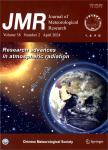Improving Multi-Model Ensemble Forecasts of Tropical Cyclone Intensity Using Bayesian Model Averaging
Improving Multi-Model Ensemble Forecasts of Tropical Cyclone Intensity Using Bayesian Model Averaging作者机构:Key Laboratory of Research on Marine Hazards Forecasting National Marine Environmental Forecasting Center Environmental Modeling Center NOAA/NWS/NCEP I.M.Systems Group Inc. and NOAA/NWS/NCEP/EMC System Research Group Inc. Colorado Springs CO 80901 and NOAA/NWS/NCEP/EMC
出 版 物:《Journal of Meteorological Research》 (气象学报(英文版))
年 卷 期:2018年第32卷第5期
页 面:794-803页
核心收录:
学科分类:07[理学] 0707[理学-海洋科学] 070601[理学-气象学] 0815[工学-水利工程] 0706[理学-大气科学] 0816[工学-测绘科学与技术] 0824[工学-船舶与海洋工程] 0825[工学-航空宇航科学与技术]
基 金:Supported by the National Natural Science Foundation of China(40830957) China Meteorological Administration Special Public Welfare Research Fund(GYHY201106018) National Basic Research and Development(973)Program of China(2011CB421504) National Science and Technology Support Program of China(2010BAC51B05) Knowledge Innovation Project of the Chinese Academy of Sciences(KZCX2-YW-Q1-02)
主 题:tropical cyclone Bayesian model average intensity bias correction forecast uncertainty ensemble forecast
摘 要:This paper proposes a method for multi-model ensemble forecasting based on Bayesian model averaging (BMA), aiming to improve the accuracy of tropical cyclone (TC) intensity forecasts, especially forecasts of minimum surface pressure at the cyclone center (Pmin)' The multi-model ensemble comprises three operational forecast models: the Global Forecast System (GFS) of NCEP, the Hurricane Weather Research and Forecasting (HWRF) models of NCEP, and the Integrated Forecasting System (IFS) of ECMWF. The mean of a predictive distribution is taken as the BMA forecast. In this investigation, bias correction of the minimum surface pressure was applied at each forecast lead time, and the distribution (or probability density function, PDF) of emin was used and transformed. Based on summer season forecasts for three years, we found that the intensity errors in TC forecast from the three models var-ied significantly. The HWRF had a much smaller intensity error for short lead-time forecasts. To demonstrate the proposed methodology, cross validation was implemented to ensure more efficient use of the sample data and more reliable testing. Comparative analysis shows that BMA for this three-model ensemble, after bias correction and distri-bution transformation, provided more accurate forecasts than did the best of the ensemble members (HWRF), with a 5%-7% decrease in root-mean-square error on average. BMA also outperformed the multi-model ensemble, and it produced "predictive variance" that represented the forecast uncertainty of the member models. In a word, the BMA method used in the multi-model ensemble forecasting was successful in TC intensity forecasts, and it has the poten-tial to be applied to routine operational forecasting.



